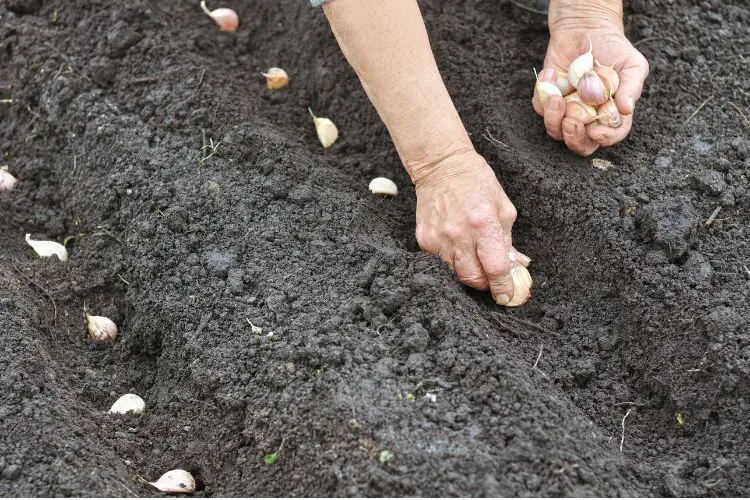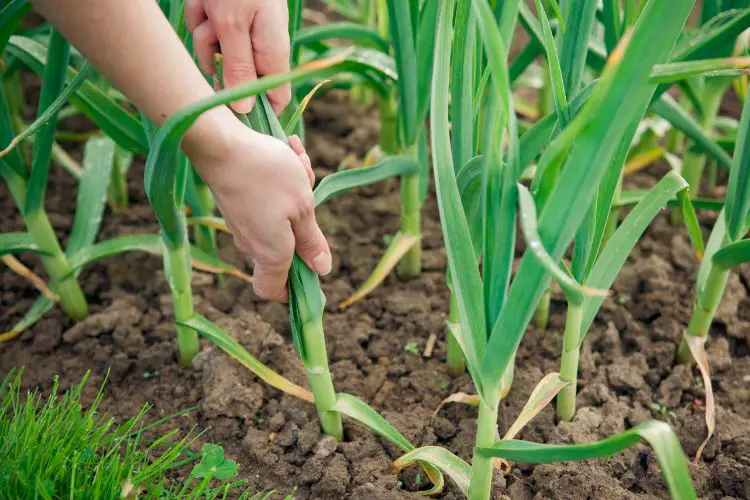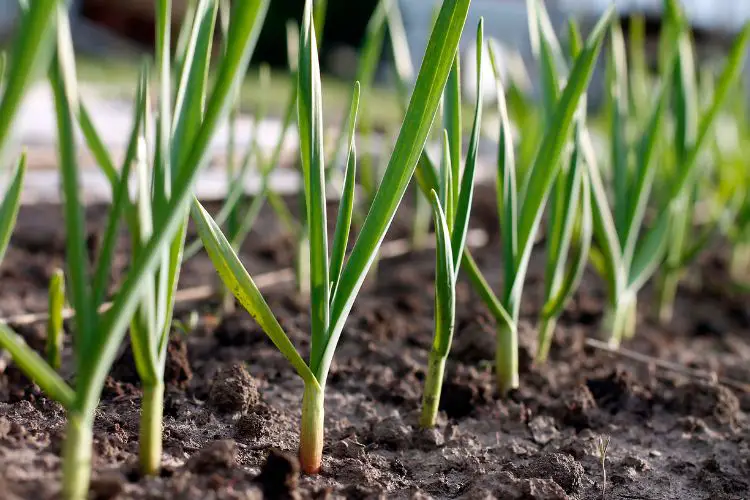Learn how to grow garlic at home with this comprehensive step-by-step guide. From selecting the right cloves to harvesting flavorful bulbs, this article will equip home gardeners with the knowledge and tips they need to cultivate their own delicious garlic harvest. Whether you’re a novice or experienced gardener, this informative piece will help you embark on a successful garlic-growing journey.

Introduction to Growing Garlic
Are you a home gardener looking to add a flavorful and versatile ingredient to your harvest? Look no further than garlic! Growing garlic at home is a rewarding and relatively low-maintenance endeavor that can yield delicious bulbs for culinary use. In this comprehensive guide, we will walk you through the step-by-step process of planting, caring for, and harvesting garlic in your own garden. Whether you’re a novice or experienced gardener, this informative piece will equip you with the knowledge and tips you need to cultivate your own delicious garlic harvest.
Benefits of Growing Garlic at Home
There are numerous benefits to growing garlic at home. Not only does it provide a fresh and flavorful addition to your culinary endeavors, but it also offers health benefits. Garlic is known for its immune-boosting properties and is a staple ingredient in many cuisines around the world. By growing your own garlic, you can ensure that it is free from harmful chemicals and pesticides, making it a healthier option for you and your family.
Overview of the Garlic Cultivation Process
The process of growing garlic can be broken down into several key steps, from selecting the right cloves to harvesting flavorful bulbs. Understanding the different types of garlic, preparing the planting site, planting the cloves, caring for the growing plants, and harvesting and storing the bulbs are all essential aspects of successful garlic cultivation. By following this step-by-step guide, you will be well-equipped to embark on a successful garlic-growing journey.
Selecting the Right Garlic Cloves
Before you can start growing garlic, it’s essential to select the right cloves for planting. There are two main types of garlic: hardneck and softneck. Hardneck garlic varieties are known for their large, easy-to-peel cloves and are well-suited to colder climates. Softneck garlic, on the other hand, tends to have smaller cloves and is better suited to warmer climates. Consider your local climate and growing conditions when choosing the best garlic varieties for your region.
Choosing the Best Garlic Varieties for Your Region

When selecting garlic varieties for your region, it’s important to consider factors such as climate, soil type, and local growing conditions. Some popular hardneck varieties include Rocambole, Porcelain, and Purple Stripe, while softneck varieties like Artichoke and Silverskin are well-suited to a wider range of climates. Research the best garlic varieties for your specific region to ensure a successful harvest.
Preparing the Planting Site
Once you’ve selected the right garlic cloves, it’s time to prepare the planting site. Garlic thrives in well-drained soil and requires full sun for optimal growth. Choose a location in your garden that receives plenty of sunlight and has good air flow to prevent disease. Additionally, ensure that the soil is rich in organic matter and has a pH level of around 6.5 for the best results.
Preparing the Soil for Optimal Garlic Growth
Before planting your garlic cloves, take the time to prepare the soil properly. This may involve adding compost or well-rotted manure to improve the soil’s fertility and structure. Ensure that the soil is free from weeds and debris, as this can hinder the growth of your garlic plants. Proper soil preparation is essential for the successful cultivation of garlic.
Planting Garlic Cloves
Now that you’ve selected the right garlic cloves and prepared the planting site, it’s time to plant your garlic. The timing of planting garlic cloves will depend on your specific climate, but it’s generally best to plant them in the fall, a few weeks before the ground freezes. When planting, ensure that the cloves are spaced about 4-6 inches apart and planted at a depth of 1-2 inches with the pointed end facing up.
Proper Spacing and Depth for Planting Garlic Cloves
Proper spacing and planting depth are crucial for the successful growth of garlic. Cloves that are planted too closely together can result in smaller bulbs, while planting them too deeply may hinder their emergence. By following the recommended spacing and planting depth, you can ensure that your garlic plants have enough room to grow and develop into flavorful bulbs.
Caring for Growing Garlic
Once your garlic cloves are planted, it’s important to provide them with the care they need to thrive. This includes regular watering, mulching, fertilizing, and managing pests and diseases to ensure a successful harvest.
When to Plant Garlic
You should plant garlic in the fall, usually in October or November. It’s best to plant it in cool weather, like when the leaves are changing color and it’s not too hot outside. That way, the garlic can grow nice and strong over the winter and be ready to harvest in the spring or summer.
Watering and Mulching Garlic Plants
Garlic plants require consistent moisture, especially during the early stages of growth. Ensure that the soil remains evenly moist, but not waterlogged, to promote healthy bulb development. Mulching around the plants can help retain soil moisture and suppress weed growth, contributing to the overall health of your garlic crop.
Fertilizing and Managing Pests and Diseases
Fertilize your garlic plants with a balanced fertilizer in the early spring to support their growth. Additionally, keep an eye out for common pests and diseases that can affect garlic, such as aphids, thrips, and white rot. Using organic methods for pest and disease control can help protect your garlic crop without the use of harmful chemicals.
Harvesting and Storing Garlic
As your garlic plants mature, it’s important to know when to harvest the bulbs for optimal flavor and storage. Proper curing and storing techniques are essential for preserving the quality of your garlic harvest.
Knowing When to Harvest Garlic
Garlic is typically ready to harvest when the lower leaves turn yellow and begin to dry out. Use a garden fork to carefully lift the bulbs from the ground, taking care not to damage them. Allow the harvested bulbs to dry in a well-ventilated, shaded area for a few weeks to cure before storing them.
Proper Curing and Storing Techniques for Harvested Garlic Bulbs
After harvesting, it’s important to cure your garlic bulbs to improve their flavor and storage life. This involves allowing the bulbs to dry in a well-ventilated area with good air flow for several weeks. Once cured, store your garlic bulbs in a cool, dry place with good air circulation to prevent them from sprouting or rotting.
Tips for Growing Garlic Successfully
In addition to the essential steps for growing garlic, there are a few tips that can help you achieve a successful harvest.
Companion Planting with Garlic
Consider companion planting garlic with other vegetables and herbs to naturally repel pests and improve overall garden health. Plants like tomatoes, peppers, and roses can benefit from being grown alongside garlic.
Using Organic Methods for Pest and Disease Control
Opt for organic pest and disease control methods to protect your garlic crop without the use of harmful chemicals. This can include introducing beneficial insects, using natural repellents, and practicing crop rotation to minimize the risk of pests and diseases.
Plant Garlic Questions & Answers

When to grow garlic outdoors?
When considering growing garlic outdoors, the best time to plant is typically in the fall, around four to six weeks before the ground freezes. This allows the garlic to establish its roots before winter sets in. In milder climates, garlic can also be planted in early spring. It’s important to choose a sunny location with well-drained soil for optimal growth. Once planted, garlic requires minimal maintenance, making it an ideal crop for both novice and experienced gardeners. By following these timing and location guidelines, you can ensure a successful garlic harvest.
When to harvest garlic?
When harvesting garlic, it is important to wait until the lower leaves have turned yellow and started to dry out. This usually occurs in late summer or early fall, depending on when the garlic was planted. To check if the garlic is ready for harvest, carefully dig up a bulb and check if the cloves have formed fully and the skin is tight around them. Once ready, carefully lift the garlic bulbs from the ground using a garden fork or shovel, taking care not to bruise or damage them. After lifting the bulbs, it is important to cure them by placing them in a warm, dry, and well-ventilated area for 2-3 weeks. This allows the outer layers of skin to dry and the flavors to intensify. Once the garlic bulbs are fully cured, trim the roots and foliage, and store them in a cool, dry place for long-term use.
How to grow garlic leaves?
Start by selecting a sunny spot with well-drained soil. Plant individual garlic cloves about 2 inches deep and 4 inches apart in the fall, with the pointed end facing upward. Water the cloves regularly, keeping the soil evenly moist but not waterlogged. Mulch the area to help retain moisture and suppress weeds. As the leaves grow, you can snip off the green tops as needed for cooking, being careful not to damage the bulb. In the spring, you may see scapes, which are curly, edible flower stalks. Remove these to encourage bulb growth. With proper care, you’ll soon have a steady supply of flavorful garlic leaves for your culinary creations.
How to grow garlic large?
To grow large garlic, it’s important to start with high-quality garlic bulbs. Choose a spot with well-draining soil and full sun. Break apart the bulbs into individual cloves and plant them about 2 inches deep and 4 inches apart, pointed end up. Water the garlic regularly, keeping the soil evenly moist but not waterlogged. Fertilize the plants with a balanced fertilizer every 3-4 weeks during the growing season. Remove any flower stalks that emerge to redirect the plant’s energy into bulb development. Harvest the garlic when the lower leaves start to turn yellow and wither, then hang the bulbs to cure in a warm, dry place for 2-3 weeks. Following these steps will help you grow large, flavorful garlic bulbs for your culinary delights.
How to grow garlic scapes?
Garlic scapes are the curly, green shoots that emerge from hardneck garlic plants in late spring. To grow garlic scapes, start by planting garlic cloves in well-drained soil in the fall. Make sure to give the cloves enough space to grow, about 4-6 inches apart. In the spring, as the plants begin to grow, keep the soil consistently moist but not waterlogged. Once the scapes start to appear, it’s important to harvest them promptly to encourage bulb growth in the garlic plants. To do this, simply snip the scapes off just above the top set of leaves. Not only are garlic scapes delicious in a variety of dishes, but their removal also directs the plants’ energy toward bulb development, resulting in larger, more flavorful garlic bulbs at harvest time.
How to grow garlic chives?
To grow garlic chives, start by selecting a well-drained spot with full sun or partial shade. Prepare the soil by adding compost or well-rotted manure to ensure good fertility. Sow the seeds directly into the soil in spring or fall, spacing them 6 inches apart. Keep the soil moist but not waterlogged, and the chives will germinate within a couple of weeks. Once they reach about 6 inches in height, you can start harvesting the leaves. Trim them off with scissors, leaving at least 2 inches of growth for regrowth. Regular harvesting will encourage the plant to produce more leaves. With proper care, your garlic chives will thrive and provide a tasty addition to your culinary endeavors.
How to grow garlic commercially?
To start, select a suitable site with well-drained soil and access to sunlight. Prepare the soil by adding organic matter and ensuring proper drainage. Next, choose high-quality garlic varieties and obtain healthy, disease-free seed garlic. Plant the cloves in the fall, ensuring proper spacing and depth. Throughout the growing season, provide adequate water, weed control, and fertilizer as needed. Harvest the garlic when the lower leaves turn brown and dry, and allow it to cure before storage. By following these steps and staying attentive to the needs of your garlic crop, you can pursue successful commercial garlic cultivation.
Can I plant grocery store garlic?
Yes, you can! While store-bought garlic may not be the best choice for planting due to the possibility of disease and limited varieties, it is still feasible. However, it is recommended to purchase garlic bulbs from a nursery or reputable seed company to ensure better quality and variety. If you decide to use grocery store garlic, look for organic bulbs as they may have a higher chance of successful growth. Keep in mind that not all grocery store garlic will sprout, so it’s important to be patient and selective when choosing the cloves for planting.
Conclusion
In conclusion, growing garlic at home is a rewarding and relatively straightforward process that can yield delicious bulbs for culinary use. By following the steps outlined in this guide, you can successfully plant, care for, harvest, and store your own flavorful garlic harvest. Whether you’re a novice or experienced gardener, we encourage you to start your own garlic-growing journey and enjoy the benefits of cultivating this versatile and flavorful ingredient. Happy gardening!
